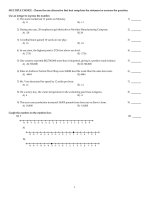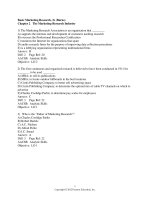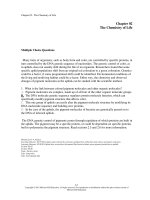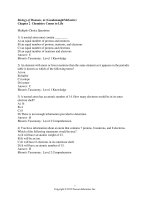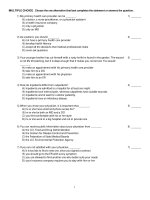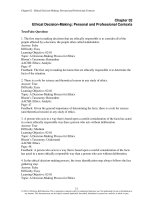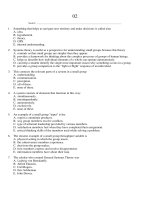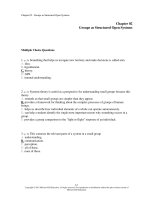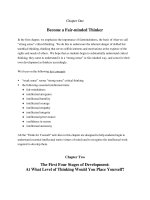Intermediate algebra with applications and visualization 3rd edition rockswold test bank
Bạn đang xem bản rút gọn của tài liệu. Xem và tải ngay bản đầy đủ của tài liệu tại đây (243.65 KB, 18 trang )
Chapter 2, Test Form A
Name:
1. Evaluate f ( −2) if f ( x ) = 4 − 3 x 2 .
2. Write a symbolic representation (formula) for a function
S that calculates the number of seconds in x minutes.
Evaluate S ( 4 ) and interpret your result.
1. _______________________
2. _______________________
_______________________
3. Sketch a graph of f ( x ) = x 2 − 2.
3.
4. Use the graph of f to evaluate f ( −1) .
4. _______________________
5. Determine the domain and range of f .
5. _______________________
19
20
INTERMEDIATE ALGEBRA: Chapter 2, Test Form A
6. A function f is represented verbally by “Square the input x
and then add 3.” Give a symbolic representation of f .
6. _______________________
7. Determine whether the graph represents a function.
7. _______________________
8. Find the domain of f ( x ) = 3 x + 7.
8. _______________________
4
9. Find the slope and y-intercept of the graph of y = 3x − 5 .
2
9. _______________________
_______________________
10. Find the slope of the line passing through
( 12 , −2) and
10. _______________________
( 0, −3) .
11. Determine the slope of the line shown in the graph.
11. _______________________
12. Write the slope-intercept form of a line with x-intercept −2
and y-intercept 3 .
12. _______________________
2
INTERMEDIATE ALGEBRA: Chapter 2, Test Form A
21
13. Write the slope-intercept form of the line passing through
13. _______________________
14. Let f be a linear function. Find the slope of the graph of f.
14. _______________________
(1,3) and ( 12 ,1) .
x
f ( x)
−4
−6
−2
0
−1
3
0
6
1
9
15. Let f be a linear function. Find the x- and y-intercepts
of the graph of f.
x
−2
f ( x) 8
0
4
1
2
2
0
3
−2
16. Give the slope-intercept form of a line parallel to
(2 )
15. _______________________
_______________________
16. _______________________
y = 5 − 4 x , passing through 1 ,1 .
17. Find the slope-intercept form for the line shown in the graph. 17. _______________________
18. Use the graph in #17 to find the equation of a line that passes 18. _______________________
through the origin and is perpendicular to the given line.
22
INTERMEDIATE ALGEBRA: Chapter 2, Test Form A
19. Find an equation of the vertical line passing through the
(2 4)
19. _______________________
point 1 , − 3 .
20. Find an equation of the horizontal line passing through the
(
)
point − 2 ,1 .
3
20. _______________________
Chapter 2, Test Form B
Name:
1. Evaluate f ( −2) if f ( x ) = −3 x + 1.
2. Write a symbolic representation (formula) for a function
C that calculates the cost of x gallons of gasoline at $2.50
per gallon. Evaluate C (10 ) and interpret your result.
3. Sketch a graph of f ( x ) = x + 3.
1. _______________________
2. _______________________
_______________________
3.
4. Use the graph of f to evaluate f ( 2) .
4. _______________________
5. Determine the domain and range of f .
5. _______________________
23
24
INTERMEDIATE ALGEBRA: Chapter 2, Test Form B
6. A function f is represented verbally by “Cube the input x
and then subtract 4.” Give a symbolic representation of f .
6. _______________________
7. Determine whether the graph represents a function.
7. _______________________
8. Find the domain of f ( x ) = x − 5.
8. _______________________
9. Find the slope and y-intercept of the graph of y = 2 x − 3.
9. _______________________
_______________________
10. Find the slope of the line passing through (1,3) and
( 12 ,1) .
10. _______________________
11. Determine the slope of the line shown in the graph.
11. _______________________
12. Write the slope-intercept form of a line with x-intercept −1
and y-intercept 5 .
12. _______________________
3
INTERMEDIATE ALGEBRA: Chapter 2, Test Form B
13. Write the slope-intercept form of the line passing through
(2 )
( 2)
25
13. _______________________
the points 3 , 2 and 1, 1 .
14. Let f be a linear function. Find the slope of the graph
of f.
x
−2
f ( x) 6
0
4
2
2
3
1
4
0
15. Let f be a linear function. Find the x- and y-intercepts
of the graph of f.
x
−2
f ( x) 9
−1
6
0
3
1
0
14. _______________________
2
−3
16. Give the slope-intercept form of a line perpendicular to
y = − 3 x − 2 , passing through ( 6, −2 ) .
15. _______________________
_______________________
16. _______________________
5
17. Find the slope-intercept form for the line shown in the graph. 17. _______________________
18. Use the graph in #17 to find the equation of a line that passes 18. _______________________
through the origin and is perpendicular to the given line.
26
INTERMEDIATE ALGEBRA: Chapter 2, Test Form B
19. Find an equation of the vertical line passing through the
(
)
19. _______________________
point − 2 ,1 .
3
20. Find an equation of the horizontal line passing through the
point
(
)
3 ,− 1 .
2
2
20. _______________________
Chapter 2, Test Form C
Name:
1. For the years 1890 to 1960, the median age for a man’s first
marriage can be modeled by f ( x ) = −0.0492 x + 119.1,
where x is the year. Find the median age in 1930. Round
answer to the nearest year.
1. _______________________
2. The median price of a single-family home during the years
2. _______________________
1990 to 2000 can be approximated by P ( x ) = 5421x + 89, 000,
where x = 0 corresponds to the year 1990 and x = 10
corresponds to the year 2000. Find the median price of a
single-family home in 1998.
3. Use your graphing calculator to graph f ( x ) = −3 x + 5.
3.
[ −6, 6, 1] by [ −6, 6, 1]
4. Susan begins driving along a country road at a rate of 40 mph. 4. _______________________
The graph illustrates the distance from her place of origin
after t hours. How far has Susan traveled after 3 hours?
[ 0, 4, 1] by [ 0, 160, 40]
5. Determine the domain and range of f .
5. _______________________
[ −6, 6, 1] by [ −6, 6, 1]
27
28
INTERMEDIATE ALGEBRA: Chapter 2, Test Form C
6. A function f is represented verbally by “Square the input
x and then subtract 4.” Give symbolic, numerical and
graphical representations of f . Let x = −3, −2, −1,...,3
in the numerical representation (table) and let −4 ≤ x ≤ 4
for the graph.
6. ______________________
[ −4, 4, 1] by [ −5, 5, 1]
7. Determine whether the graph represents a function.
7. _______________________
[ −4, 4, 1] by [ −6, 6, 1]
8. Find the domain of f ( x ) = x − 2.5 .
8. _______________________
9. The monthly cost of operating a car can be modeled by
the linear function C ( x ) = 0.39 x + 395, where x represents
the number of miles driven.
(a) Find the slope of the graph of the function.
What does the slope represent?
(b) Find the y-intercept of the graph of the function.
What does the y-intercept represent?
9. (a)_____________________
10. In 1994, tuition and fees at a public four-year college were
$2125. In 1997, tuition and fees increased to $2689. What
was the average yearly increase in fees from 1994 to 1997?
(b)_____________________
10. _______________________
INTERMEDIATE ALGEBRA: Chapter 2, Test Form C
29
11. The graph represents the amount of water (in gallons)
remaining in a tank after t hours. At what rate was
water being drained from the tank when 2 ≤ t ≤ 4 ?
11. _______________________
12. Write the slope-intercept form of a line with x-intercept
1.29 and y-intercept –2.58.
12. _______________________
13. On Labor Day 2000, there were 24.8 travelers (in millions).
On Labor Day 2004, there were 29.2 travelers (in millions).
Let x represent the number of years since 2000. Write the
slope-intercept equation of the line that passes through
( 0, 24.8 ) and ( 4, 29.2 ) .
13. _______________________
14. The following table shows equivalent temperatures in
degrees Celsius and degrees Fahrenheit. This data can
be modeled by a linear function. Use your graphing
calculator to find the slope of the graph of that function.
14. _______________________
C
−40D
0D
15D
35D
100D
F
−40D
32D
59D
95D
212D
15. (a) Find the y-intercept of the graph of the linear function
modeled in #14.
(b) What does the y-intercept represent?
15. (a)_____________________
16. Give the slope-intercept form of a line parallel to
y = 1.28 x − 7.18, passing through ( 2, 3.17 ) .
16. _______________________
(b)_____________________
30
INTERMEDIATE ALGEBRA: Chapter 2, Test Form C
17. Find the slope-intercept form for the line shown in the graph. 17. _______________________
[ −6, 6, 1] by [ −6, 6, 1]
18. Use the graph in #17 to find the equation of a line that passes 18. _______________________
through the origin and is parallel to the given line.
19. Find an equation of the horizontal line in the graph.
19. _______________________
[ −6, 6, 1] by [ −6, 6, 1]
20. From 1980 to 1997, the number of U.S. marriages
(in millions) could be modeled by f ( x ) = 2.4 , where
x represents the years since 1980. Estimate the number
of marriages in 1986.
20. _______________________
Chapter 2, Test Form D
Name:
1. Evaluate f ( −3) if f ( x ) = − x 2 + 2.
(a) 11
(b) −7
1. _______
(c) −11
(d) −1
2. Evaluate f ( 2) if f ( x ) = −5 x + 6.
(a) −4
(b) −16
2. _______
(c) 16
3. Sketch a graph of f ( x ) = x − 2.
(d) 4
3. _______
(a)
(b)
(c)
(d)
31
32
INTERMEDIATE ALGEBRA: Chapter 2, Test Form D
4. Use the graph of f to evaluate f (1) .
(a) 2
(b) 7
4. _______
(c) 1
(d) 3
5. Determine the range of f.
(a) −4 ≤ y ≤ 2
(b) −2 ≤ y ≤ 2
5. _______
(c) y ≥ −4
(d) all real numbers
6. A function f is represented verbally by “Cube the input x and then add 4.”
Give a symbolic representation of f .
(a) f ( x ) = 3 x + 4
(b) f ( x ) = x3 + 4
(c) f ( x ) = x 3 + 64
(d) f ( x ) = ( x + 4)
3
6. _______
33
INTERMEDIATE ALGEBRA: Chapter 2, Test Form D
7. Determine which graph represents a function.
(a)
(b)
(c)
(d)
8. Find the domain of f ( x ) = −
(a) x ≠ −4
(b) x ≤ 4
7. _______
2x
.
x+4
8. _______
(c) x ≠ 0
(d) x ≥ 0
9. Find the slope and y-intercept of the graph of the linear equation y = 3x − 5 .
9
2
(6 )
(a) m = 3; 5 , 0
3
( 6)
(
(c) m = − 1 ; 0, 5
3
(
(b) m = − 1 ; − 5 , 0
2
(d) m = 3; 0, − 5
(2 )
2
)
)
( 2)
10. Find the slope of the line passing through 3 , 2 and 1, 1 .
(a) 1
(b) 3
(c) 1
3
10. _______
(d) −1
34
INTERMEDIATE ALGEBRA: Chapter 2, Test Form D
11. Determine which line has a slope of 1 .
11. _______
3
(a)
(b)
(c)
(d)
12. Write the slope-intercept form of the line with x-intercept 3 and y-intercept 3 .
4
(a) y = − 1 x + 3
(b) y = 4 x − 12
4
(c) y = − 1 x + 3
4
(d) y = 4 x + 3
4
(2 )
13. Find the slope-intercept form of the line passing through 1 , −2 and ( 0, −3) .
(a) y = 1 x + 5
2
(b) y = 1 x − 3
2
4
(c) y = 2 x − 3
−2
0
1
2
4
y
8
4
2
0
−4
(a) −2
(b) 4
(c) −4
13. _______
(d) y = 2 x + 1
14. Let f be a linear function. Find the slope of the graph of f .
x
12. _______
14. _______
(d) 2
35
INTERMEDIATE ALGEBRA: Chapter 2, Test Form D
15. Let f be a linear function. Find the x- and y-intercepts of the graph of f .
x
−4
−2
−1
0
1
y
−6
0
3
6
9
(a) x-int : ( 0, 6 )
y -int : ( −2, 0 )
(b) x-int : ( 0, −2 )
y -int : ( 6, 0 )
(c) x-int : ( 6, 0 )
(d) x-int : ( −2, 0 )
y -int : ( 0, −2 )
y -int : ( 0, 6 )
16. Give the slope-intercept form of a line perpendicular to y = 2 x + 7,
(a) y = − 3 x + 3
2
16. _______
3
passing through ( 4, −3) .
(b) y = 2 x − 17
3
3
(c) y = 2 x − 7
3
(d) y = − 3 x − 3
2
17. Find the graph of the linear equation y = −3 x + 4.
(a)
(b)
(c)
(d)
17. _______
18. Find the equation of a line that passes through the origin and is perpendicular
to the line given in #17.
(a) y = −3 x
(b) y = 1 x
3
(c) x = −3 y + 4
15. _______
(d) y = 1 x + 4
3
18. _______
36
INTERMEDIATE ALGEBRA: Chapter 2, Test Form D
(2 2)
19. Find an equation of the vertical line passing through the point 3 , − 1 .
(a) 3 x − 1 y = 0
2
2
(b) x = 3
(c) y = − 1
2
2
19. _______
(d) y = 3 x − 1
2
2
(2 4)
20. Find an equation of the horizontal line passing through the point 1 , − 3 .
(a) y = − 3
4
(b) y = 1 x − 3
2
4
(c) x = 1
2
(d) 1 x − 3 y = 0
2
4
20. _______

